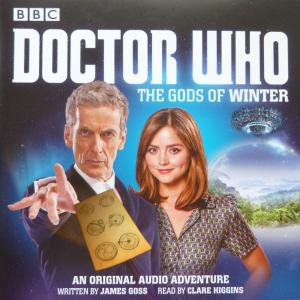New Adventures With The Eleventh Doctor #13 - Conversion Part 2

WRITER: Rob Williams
ARTIST: Warren Pleece, COLOURS: Hi-Fi
LETTERER: Richard Starkings + Comicraft's Jimmy Betancourt
DESIGNER - Rob Farmer, EDITOR - Andrew James
ASSISTANT EDITOR- Kirsten Murray
PUBLISHER: Titan Comics
RELEASE DATE: June 17, 2015
"The entity with the might of a Cyberman army... an army that now shows you what your heart wants most as they attack. That is... unstoppable. Oh... oh no... They’re going to conquer everything" The Doctor under a mysterious influence, and seemingly losing hope.
Having done a bit of globe-and-time-and-space trotting in the first instalment, this second and final comic 'episode' now focuses on a singular setting. Thus it can pay full dues so as to make the most of the premise and circumstances that were established. Tension rarely leaves from panel to panel and page-to-page, and some fine dialogue intermingles with well-done action visuals.
Using Romans in Doctor Who has often been very effective, were viewers or fans of any generation to recall watching the Dennis Spooner story in William Hartnell's era, or (brief) sections of Patrick Troughton finale The War Games. So the pedigree is there, in addition to modern Who efforts with Matt Smith and David Tennant, and goes back to almost the dawn of this (happily) never-ending story. Also, the sheer depth of Roman society will continue to offer any number of further settings and hierarchy-society thematic exploration.
By contrast, as much as I love the concept and aesthetics of the Cybermen I must admit their full potential is not always realised. This story does a neat job of making their conversion/ horror theme come to the boil, and yet offer a different actual opponent for the Doctor. The artwork from Warren Pleece also does a fine job of using the sheer height and presence of the Cyber-army, with some moody background imagery and colours to really make them stand out.
Themes of steadfastness and cowardice come into operation here with the civil war being decided not by conventional battle but by the way the two opposing leaders respond to the threat of the Entity/Cyber-Army. In the end one is shown to pay the ultimate price and in ignominious fashion, and the other, whilst not understanding everything properly has such integrity at his core that he and his followers live to fight another day. There is also that subtle bit of extra depth where we are not forced to believe one was wholly good and the other bad, and the Doctor may have helped someone with a lot of blood on his hands and demons in his head. No mistake should be made that these were brutal times in human history. But the Doctor just does the best he can to achieve the ideal outcome, even if on the surface this Eleventh incarnation is bumbling or lackadaisical at times.
In addition to well-sketched supporting characters. there is enough care and attention from Rob Williams' writing to incorporate some interesting consequences of having a contemporary 21st century Londoner suddenly transposed into the days of the Roman Empire. This is seen when Alice is simplistically referred to as a 'warrior princess' by one of the feuding Emperors, due to her skin-colour and her assertive manner. Alice has always been given a good deal of focus and development as I have stated in my prior reviews, but this issue is particularly strong for her and without her concerted input the outcome would almost certainly be a different one. We again also have some brief flashbacks to her past which still feel involving and not just treading the same old pathways. I for one now eagerly anticipate her use in the new Four Doctors event that is being released imminently.
Let there be no misunderstanding: the Doctor does have much to do come the end, but for certain moments he is haunted by the mysterious Time Lord that has intermittently popped up since the very first issue. And despite using his ingenuity, he still cannot prevent a game changer that leaves one member of the quartet cut off and seemingly unreachable. The remainder may have to take the long route to find their associate, as problems with the TARDIS continue to persist. Overall this latest multi-parter from the Eleventh Doctor line has presented a neat twist or two, and made proper use of the TARDIS crew. The denouement is perfectly paced and does not veer into the 'easy out' that some of the Matt Smith TV stories were arguably guilty of.
Bonus Humour Strip:
A typically strong effort from Marc Ellerby with a good plot, fizzy dialogue and a good range of cartoonish facial expressions. That old chestnut of where to go on Summer Wholiday gets a welcome inspection in the humour coda, and again the two page format is totally justified. Out of the River/Doctor and Amy/Rory family set, only one individual gets a properly satisfying vindication of their chosen destination.








